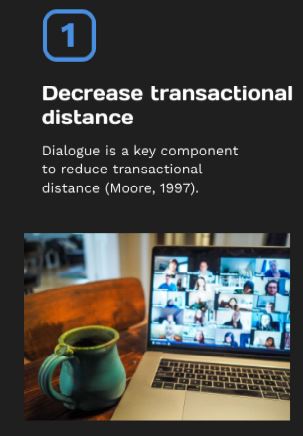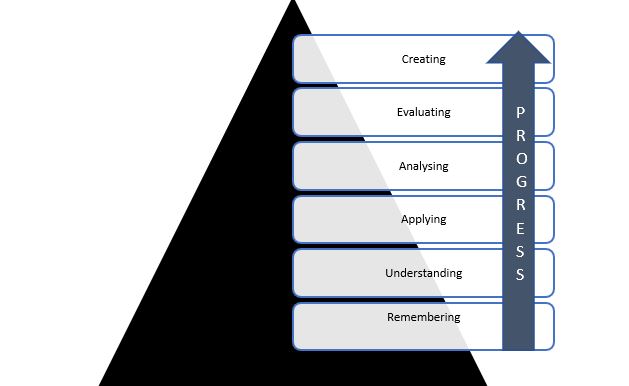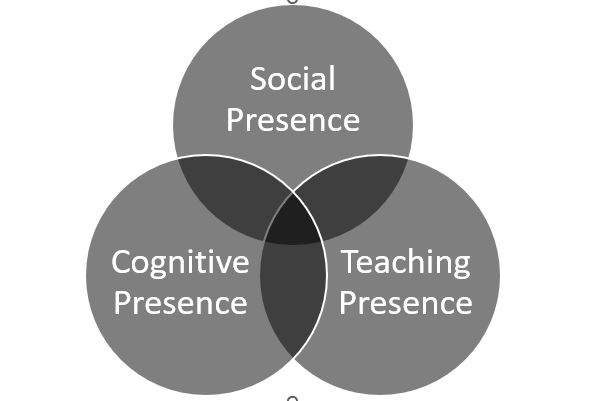Learning theories are like the secret sauce in instructional design. They guide the creation of effective learning experiences by providing insights into the learning process, informing personalized instruction, shaping assessments, and addressing challenges like motivation. In my ePortfolio, I emphasize the importance of integrating these theories into my instructional design practices to continually enhance learning outcomes and create engaging educational content.

Transactional Distance
The transactional distance theory is one of the core theories of distance education (Giossos, Koutsouba, & Lionarakis, 2009). Moore (1993) described transactional distance as the “psychological and communications space” (p. 22) that occurs between the learner and the teacher. Moore (1993) described the physical separation of the teacher and the student with the theory, a concept that describes the relationship that occurs when they are separated by time and location. Moore (1993) explained furthermore that the “psychological and communication space” (p. 22) can lead to misunderstandings in any educational environment. This misunderstanding is called transactional distance. To enhance student understanding, student satisfaction, and learning outcomes, the transactional distance needs to be minimized (Best & Conceição, 2017). The factors that influence transactional distance are the structure of the program, the dialogues that occur between the learner and the instructor, and the individual’s autonomy (Giossos, Koutsouba, & Lionarakis, 2009). Dialogue and structure refer to teaching methods, whereas autonomy refers to the learner’s behavior (Best & Conceição, 2017). Transactional distance between learner and teacher is greater, when a course program is highly structured and when communication is limited (Moore, 1993). Therefore, programs with little transactional distance have an open structure, allowing students to enhance their knowledge through dialogues (Moore, 1993).

Cognitivism
Cognitivism derived from behaviorism in the late 1950s and early 1960s (Clark, 2018). The human mind is no longer is not a black box. Cognitivists see the mind as the core in the learning process to include thinking, recalling, interpreting, and problem-solving (Clark, 2018). In simple words, the emphasis is on what is going on inside of the "black box" (see the previous post on behaviorism). The theory of cognitivism emphasizes that learning and acquiring knowledge is an internal activity. Clark (2018) stated that "cognitivism refers to the study of the mind and how it obtains, processes, and stores information" (p. 176).
Key theorists include Jean Piaget and Benjamin Bloom. Piaget studied and observed children and how they learn. Learning is combining the already known with new knowledge through observation, categorization, perception, and reasoning. The theory of cognitivism views the learner as an active rather than a passive participant. The following pyramid based on Bloom, Anderson, and Krathwol (as cited in Bates, 2019) explains the learning process from a cognitivist view:

Constructivism
Constructivism emphasizes “consciousness, free will and social influences on learning” (Bates, 2019, p. 81). Learning and creating knowledge is an active process that occurs within each individual. Bates (2019) described that each learner creates meaning based on past experiences. Besides, Ally (2008) added that individuals interpret information differently according to “their personal reality” (p. 19). She stated that the constructivist approach promotes higher-level thinking and is best used to teach processes, the why. Constructivism is student-centered. Constructivists see the learner as the core and the instructor as a facilitator (Ally, 2008). A significant component of learning that behaviorism and cognitivism did not include is the social aspect of learning. Bates (2019) emphasized that “learning is seen as essentially a social process” (p.). The learner must actively construct knowledge. Major theorists include Piaget, Dewey, and Vygotsky. Piaget focused on the cognitive and intrapersonal process, whereas Vygotsky introduced social constructivism (Liu & Matthews, 2005).
Connectivism
Connectivism is a new learning theory that includes the digital age. Previous learning theories that I have covered in my learning journals like behaviorism, cognitivism, and constructivism originated before digitalization. However, technology influences our daily life, how we communicate with each other, and how we learn (Siemens, 2005). Therefore, connectivism, a theoretical framework, evolved due to the emergence of technology. So, what is different about connectivism?
Connectivism is a learning theory that helps to understand how technology impacts learning. It relates to today's complex, connected, and rapidly changing society (Duke, Harper & Johnston, 2013) and relies on networking as the basis to create knowledge. According to Barnett et al. (2013), "Connectivism is an epistemological approach grounded in the interactions within networks" (p.
686). Siemens (2005) explained that it is "the integration of principles explored by chaos, network, and complexity and self-organization theories" (p. 4). Knowledge creation is shifting and changing and heavily influenced by the internet (Bates, 2019).
Siemens, Downes, and Cormier constructed the first massive open online course (MOOC) and introduced connectivism (Bates, 2019). This initial MOOC was free, available for everyone with a computer and internet connection, and pre-requisites were not required (Bates, 2019).
COI
The community of Inquiry (CoI) attempts to "define, describe and measure the elements of collaborative and worthwhile educational experience" (Garrison et al., 2010, p. 6) through three components: social, cognitive, and teaching presence (Garrison et al., 2010).

The framework focuses on a community of learners and supports collaborative learning underlying the constructivists' learning theory. Garrison, Anderson, and Archer are the major theorists associated with the Community of Inquiry model.
